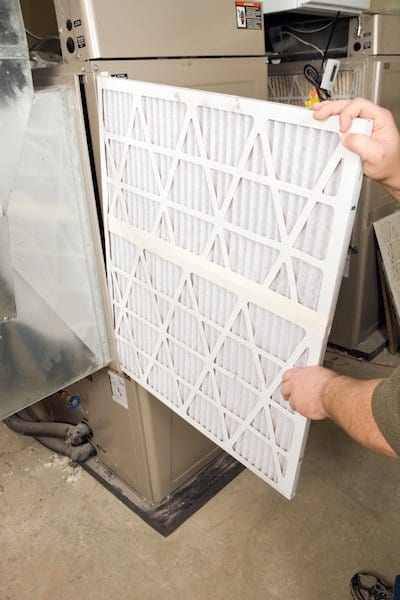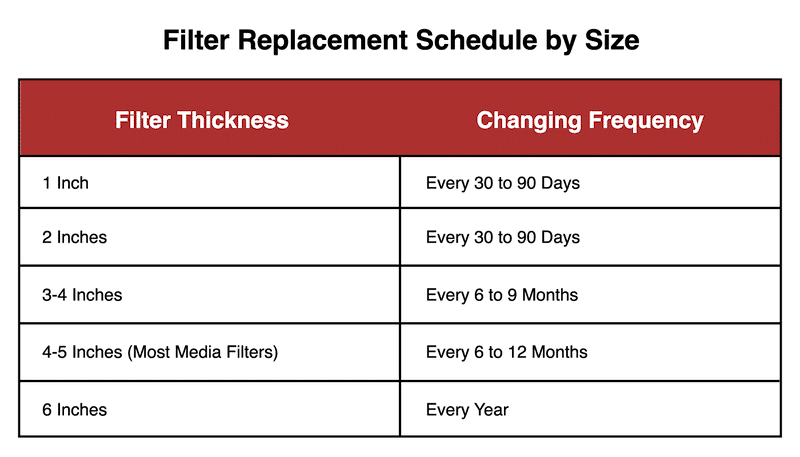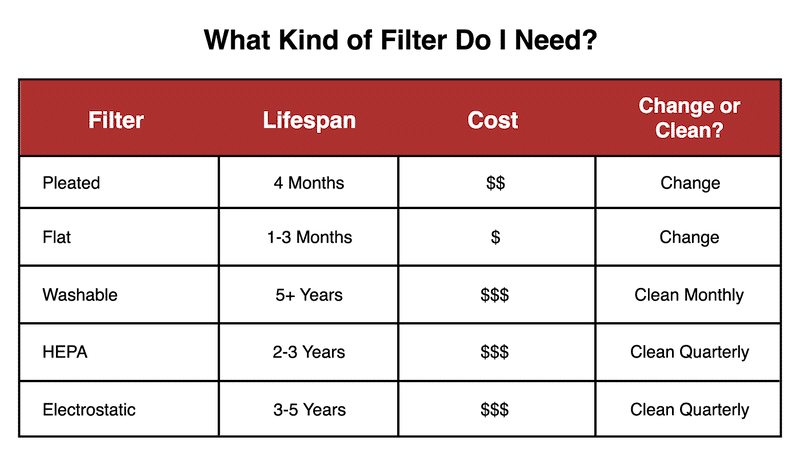
- Filter Thickness
- Air Quality
- Home Size: bigger = change more often
- Pets in the Home: fur and dander clog filters more quickly and even more quickly with more than one pet in the house
- Climate Where You Live: For example, hot summers in Nashville vs. mild ones in Milwaukee mean these homeowners will have different needs when it comes to changing their furnace filter.
Did you know that one of the most straightforward home maintenance tasks you can perform is furnace filter replacement? Yet it is one of the most commonly forgotten household chores – likely due to the fact that homeowners either:
- don’t know exactly how often to change an HVAC filter
- don’t know how to change it
- it’s not a weekly task
Energy Star recommends checking your furnace filter monthly – especially during the summer and winter months that require the HVAC system most.

Signs Your Furnace Filter Needs To Be Changed
Several signs will tell you it is time for an HVAC filter replacement. When you notice them, change the filter as soon as possible. Waiting too long can cause health issues, broken furnace parts, system failure, and higher bills because the furnace is forced to work harder to pump air and achieve proper airflow.
You are ready to change furnace filter if:
- You check your furnace filter and find it gray, dirty, and dusty.
- Your HVAC system is running more than normal.
- Your home is dustier than usual – and not because you haven’t had time to dust. Although, the more you clean (vacuum and dust), the less your furnace has to trap and the less frequently you have to change the filter.
- There are odd, or burning smells near the furnace.
- You leave windows and doors open regularly. This allows outdoor allergens to make their way inside and clog up your filter faster.
- You smoke indoors. This too, will clog the furnace filter faster.
What To Know About Furnace Filter Selection
Air Filter types are based on the materials they are made from and the size of the particles – measured in “microns” – that they effectively block. Anything five microns or larger can be seen by the human eye. However, most of the particles and contaminants found in indoor air are less than one micron in size. Take a close look at the “micron rating” when choosing a furnace filter. A filter with a micron rating of “5” means the filter can block particles down to a size of 5 microns.
With filter selection, be sure to note the dimensions, thickness, and “Minimum Efficiency Reporting Value (MERV) of the existing filter before you head to the hardware store. The higher the MERV, the more efficient the filter is.(1) The furnace filter should fit snugly enough that it is firmly in place but can also still be slid from its slot.
Most Common Kinds of Furnace Filters
There are various filter types used with furnaces, including these popular options:
- Pleated Air Filters – Most commonly made of cotton or polyester. These are usually disposable filters. Good at filtering out harmful pollutants down to 0.3 microns, including viruses and bacteria.
- Fiberglass Air Filters – Sometimes referred to as “synthetic filters,” good at filtering out dust and particles down to 5 microns, but not a strong choice for blocking smaller toxic contaminants.
- HEPA Filters – “High-Efficiency Particulate Air” Filters are sometimes considered the “gold standard” for filters, blocking nearly all particles down to 0.3 microns.(2)
- Electrostatic Filters – These use a charge to attract particles like magnets and can work to trap down to 0.3 microns. They become less effective when using washable filters.

You can keep it simple when considering furnace filter sizes – get the exact size it came with upon installation or when you moved into your home.
How to Change Furnace Filter
The good news is, changing your furnace filter is one of the easiest home maintenance tasks. You can DIY on this one!
- First things first, turn off the furnace.
- Locate your filter (typically on the front or side of furnace).
- Remove the cover or just slide the filter out of its slot, depending on your furnace.
- Replace filter, inserting it with the arrow pointing toward the furnace’s motor blower. Then replace the cover (if your furnace has one).
- Turn on the furnace again.
For washable filters, you can vacuum and rinse it off to clean it, or use compressed air to extend the life of your filter.
If you do not know how to turn off your furnace or are unsure about the size filter you should be using, or just aren’t comfortable doing this household chore, listen to your instincts. Call a professional HVAC contractor. They can provide the information, the maintenance, and the filters you need (courtesy of a Home Protection Plan) and show you how it is done if you are more comfortable once you know what you need and know the process for next time.
Making sure your furnace filters are clean and changed regularly means not only a cleaner, healthier home, it also means a utility bill that is 5 to 15% less.(3)
FAQs About Changing Your HVAC Filter
Yes, replacing your furnace filter can be one of the easiest home maintenance tasks you can perform.
Yes, the first step of changing your filter should be to turn off the furnace.
Depending on the type, size, and MERV rating, a furnace filter can cost $4 to $60+. A Home Protection Plan will often include these without additional cost.
With a furnace filter installed backward, your furnace will have to work harder to achieve airflow, and it could damage your furnace.
Yes, these terms are used interchangeably (along with HVAC filter) for the same filter if you have a central HVAC system.


